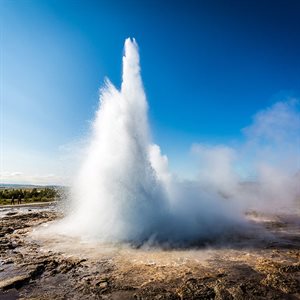WHAT IS GEOTHERMAL ENERGY? HOW DOES IT WORK?

Geothermal energy is a type of renewable energy taken from the Earth’s core. It comes from heat generated during the original formation of the planet and the radioactive decay of materials. This thermal energy is stored in rocks and fluids in the centre of the earth.
 The difference between the temperature in the earth’s core and the surface drives a continuous conduction of thermal energy from the centre to the exterior of the planet.
The difference between the temperature in the earth’s core and the surface drives a continuous conduction of thermal energy from the centre to the exterior of the planet.
High temperatures of over 4000°C cause some of the rock in the centre of the Earth to melt and form hot molten rocks called magma. These heats also cause the mantle to behave plastically and portions of it to convect upwards, since it is lighter than the surrounding rock.
The rock and water in the Earth’s crust can reach heats of around 370°C.
Thermal energy contained in the rocks and fluids can be found from shallow depths right down to several miles below the Earth’s surface.
The Meaning of Geothermal Energy
The word ‘geothermal’ has Greek roots with γη (geo), meaning earth, and θερμος (thermos), meaning hot.
How is it Used?
It has been used in some countries for thousands of years for cooking and in heating systems. The underground geothermal reservoirs of steam and heated water can be used for electricity generation and other heating and cooling applications.
One example of heating and cooling is where a geothermal heat pump is installed around 10 feet underground. These pipes are filled with water or an antifreeze solution. The water is pumped around the closed loop of pipes. These ground source heat pump systems help to cool buildings in summer and maintain warmth in summer. This occurs by absorbing the earth’s heat as the water circulates back into the building.
Geothermal water has been used to help grow plants in greenhouses, for district heating in homes and businesses. It can also be piped under roads to melt snow.
How is Geothermal Energy Produced?
Wells of up to a mile deep or more are drilled into underground reservoirs to tap into the geothermal resources. These resources can be exploited from naturally occurring heat, rock and water permeability or through enhanced geothermal systems, which enhance or create geothermal resources through a process called hydraulic stimulation. These geothermal resources, whether natural or enhanced, drive turbines linked to electricity generators.
The first recorded instance of geothermal heat being used for producing electricity was in Larderello, Italy in 1904. Yet, geothermal heat has been used for bathing since the Palaeolithic Age. Monkeys in Japan have also been shown to use heated water from hot springs to keep warm during winter months in mountainous regions.
How Does Geothermal Energy Work?
Geothermal power plants come in three different designs; dry steam, flash and binary:
- The oldest type is dry steam, which takes steam directly from fractures in the ground to drive a turbine.
- Flash plants pull high pressure hot water from underground and mix it with cooler low pressure water. This, in turn, creates steam that is used to drive a turbine.
- Binary plants use hot water passed through a secondary fluid that has a lower boiling point than water. The secondary fluid is turned into vapour which drives a turbine. Most future geothermal power plants are expected to be binary plants.
The United States is the world’s largest producer. They also have the largest geothermal development in the world, situated at The Geysers north of San Francisco, California. Despite the name, there are no geysers there and the energy used is all steam rather than hot water.
The first power generation well was sunk in 1924, with more wells drilled in the 1950s and further development taking place from the 1970s on.
Other nations, such as Iceland, are well placed to exploit geothermal resources, which they have done since 1907. With 25 active volcanoes and 600 hot springs, 25% of Iceland’s energy comes from five geothermal power plants.
What are the Advantages and Disadvantages?
As a source of renewable energy, the main advantages of geothermal energy are environmental. It produces just one-sixth of the carbon dioxide emitted by a clean natural-gas power plant.
Geothermal is also cheaper than conventional energy, with savings of as much as 80% compared with fossil fuels.
Unlike other renewable energy sources, such as solar and wind, it is constantly available.
Despite being inexpensive, sustainable and environmentally-friendly, geothermal is not without its drawbacks.
Firstly, production is limited to areas near tectonic plate boundaries. In addition, some locations may cool down after decades of use.
Although it is cheaper than fossil fuels once a plant has been built, the drilling and exploration of these sites is expensive. This is in part due to the amount of wear experienced by drills and other tools in such aggressive environments.
Geothermal plants can release hydrogen sulphide, a gas that smells like rotten eggs. Finally, some geothermal fluids contain low levels of toxic materials which need to be disposed of.
Geothermal and TWI
Due to TWI’s expertise in coatings and material properties, in addition to our extensive work in oil and gas, we are perfectly placed to use this expertise in the field.
For example, TWI’s knowledge of wear-resistant materials provides potential solutions for geothermal drilling. In addition, our knowledge of structural integrity and integrity management, as well as our expertise in joining have direct applications to geothermal projects.
TWI has already been working on a number of projects alongside some of the world’s leading geothermal technology and energy businesses.
Courtesy of TWI Global
